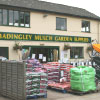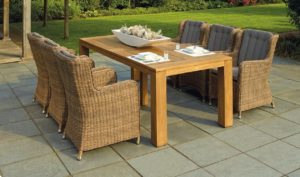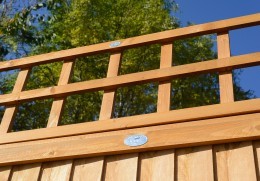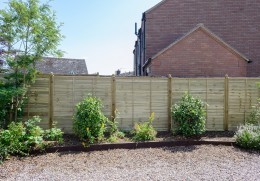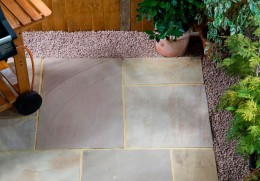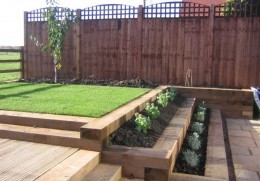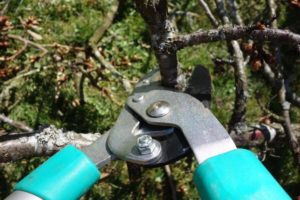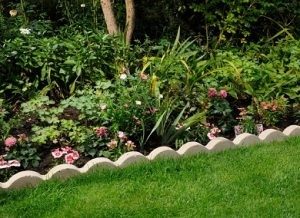Five Top Tips for Effective Weed Control
Weeds are the bane of any gardener’s life – not only do they look unsightly, but they also can inhibit the growth of your flowers and shrubs by depriving them of valuable soil nutrients.
Madingley Mulch provide a wide range of gardening supplies to customers in Bedfordshire, Hertfordshire, Essex and Suffolk, as well as our home county of Cambridgeshire. Here are our top five top tips for keeping weeds under control.
Don’t Forget to Mulch
Mulches will stifle the life out of any weeds by depriving them of light. Organic mulches, such as those containing bark or wood chips, are particularly effective, as they are an ideal habitat for beetles and crickets. These insects feast on weed seeds just below the surface of the soil and prevent them from germinating.
You should always top up your mulch so it is at least 10cm (4in) deep, as this will smother established weeds. And leave a small gap around your plants, as some can be damaged by direct contact with the mulch.
Madingley Mulch supply a wide range of mulches, soil conditioners and composts which will help your plants to grow. These include Denise’s Delight and Tony’s Tonic, two exclusive products which contain horse manure, wood shavings and other effective plant nutrients.
Mind the Gaps
Weeds flourish in the gaps between plants, so crowd them out. Mass plantings of closely-spaced flowers and shrubs will be far more effective than a lot of widely-scattered ones. However, don’t be tempted to put them too close together. Remember that your plants will be competing for the same soil nutrients, and there is also a risk that you could transmit diseases from one plant to another.
Don’t Dig Too Deep
Many weeds grow from seedlings in your garden soil – but only those within an inch or two of the surface get enough light to germinate. So if you do dig out a pesky plant, all you might be doing is creating the conditions for others to thrive. Uproot them where possible, rather than digging them out, and cover the disturbed area with mulch or a new plant.
The best approach to take will depend on the weather. As the old saying has it, ‘pull when wet, hoe when dry’. So, after a spell of rain, the damp soil will allow you to uproot some weeds far more easily. However, if you have had a spell of sunny weather, then running a hoe over your bed or between rows of plants will kill most seedlings. Ideally, do this on a dry day with light winds, as the weeds will dry out on the surface of the bed rather than re-rooting themselves into moist earth.
Lawncare
Weeds growing in your lawn create a different set of problems. Regular watering, particularly during the summer, and some vigorous raking or scarifying beforehand, will help your grass grow and make it more difficult for weeds to compete for the soil nutrients. Madingley Mulch also supply a lawn top dressing mix to feed the roots of your grass.
However, persistent plants such as dandelions and daisies can still cause problems. These should be removed with a hand fork, making sure you pull out all of the root, and then reseed or returf the bare patches if necessary. The best time to do this is usually in the spring or autumn, when the soil is neither too damp nor too dry, as this provides the ideal growing conditions for the new grass seed or turf roots.
A Helping Hand
You can make your life – and your plants’ lives – easier with some artificial assistance. Weedkiller, such as Round-Up, supplied by Madingley Mulch, will kill the majority of all these unwanted plants with just one application.
We also supply Groundtex, a high-quality garden membrane which will help suppress the most stubborn of weeds, and won’t get damaged by animals. You can also use it as a sub-base for a patio and other building works, and for general ground stabilisation.
Gardening Supplies from Madingley Mulch
Whether you want mulches, composts, or other specialist products such as a weed suppressing membrane or a lawn top dressing mix, gardening supplies specialists Madingley Mulch are the people to call.
We can deliver your order whether you live in Bedfordshire, Hertfordshire, Suffolk, Essex or Cambridgeshire – this is free to all addresses within 15 miles of our base on the edge of Cambridge. If you live within 24.5miles, then a standard £20 charge applies, and we can also deliver further away as well. Follow this link if you would like to learn more about our delivery services.
How to Create a Pet-Friendly Garden
Many families love their pets just as much as their gardens, but the two don’t always go together well. Pets can do a lot of damage to plants, and vice versa – dogs and cats could eat flowers and shrubs which may be potentially poisonous.
Madingley Mulch supply soil conditioners to customers in Cambridge and the surrounding area. Here are our top five key factors to consider if you want your pets and your plants to thrive alongside each other.
Deter Animals Digging
One of the most frustrating experiences for gardeners can be to find that a prized flower bed has been dug up by your dog or cat, or by the neighbours’. Bare ground is an open invitation for animals to dig, so make sure your plants are protected in some way.
Slate chippings should deter the most active of cats and dogs. Mulches, such as Denise’s Delight, our exclusive mixture of Black Fen soil, horse manure and other plant nutrients, can also be used, with a covering of wire underneath for added protection. It’s advisable to check that your mulch doesn’t contain any ingredients which could be harmful to animals before you spread it over your beds. The same advice applies to any pesticides and fertilisers you use.
Think Big
Small, delicate flowers are more likely to be damaged by animal claws than medium-sized trees, shrubs and perennials. Viburnum, shrub roses and lavender are all sturdy plants which should be able to withstand dogs and cats running through them.
Another possible solution is to add a stone pathway at the back of the bed you have just planted out. Since dogs are instinctively drawn towards the boundaries of any garden, this should ensure any new flowers don’t get trampled.
Create Special Areas
Your cat or dog is much less likely to damage your flowers and shrubs if they are actively encouraged to use another part of the garden. In the case of dogs, consider creating a sheltered ‘digging zone’, complete with a favourite toy or two, where they can enjoy themselves.
Cats should be provided with plenty of places to climb, as well as an outdoor litter tray or patch of sand so they don’t use your beds as a giant toilet. And make sure they have somewhere to sharpen their claws like an old log. If you have plenty of places to hide, it will make them feel safer and more secure, particularly if your neighbours have cats of their own.
Add Fences for Safety
Smaller pets, such as rabbits and guinea pigs, benefit from being allowed a run-around in the garden every so often, rather than being confined to their hutches. Make sure there aren’t any holes in your fences or gates, as you will be surprised at how easily they may be able to squeeze through them. And remember that medium-sized dogs can jump at least 6ft high if you are buying a fence for your back garden.
Fences also protect vegetable gardens, ensuring that your crop won’t be damaged either by your own pets or a neighbour’s. Ponds and should also be fenced off and tool sheds locked, to prevent your animals – and any young children – from coming to any harm.
Plant Healthily
Your rabbit will love you if you have a plentiful supply of green vegetables and carrots, so why not grow your own? If you have a tortoise, then don’t feel you have to pull up all the dandelions, as they love grazing on these plants.
For times when your dog is suffering from any form of nausea or indigestion, then plant some peppermint for them to nibble on and you should find that their stomach problems will soon be eased. Equally, many common plants, including chrysanthemums, daffodils, foxgloves and hydrangeas, are potentially poisonous for your canine companion, so take care about planting these.
Cats go wild for the scent of catnip and catmint, but you should avoid planting them if you don’t have a moggy and your neighbours do – otherwise you could suddenly find your garden suffering from a feline invasion.
With Madingley Mulch
Soil conditioners specialists Madingley Mulch can help you if you want your garden – whether it’s in Cambridge, Essex, Suffolk, Bedfordshire or Hertfordshire – to become more pet-friendly.
We supply slate chippings, sand, fencing panels and posts, as well as a wide selection of mulches and composts. Our friendly, experienced staff will be able to advise you on which products will be safe to use if your house is also home to a pet or two. Follow this link if you want to know more about our current range of products.
We deliver free to all addresses within 15 miles of our base on the outskirts of Cambridge, and there is a standard £20 charge for all addresses within 24.5 miles. Deliveries further away can also be arranged. Our weekly delivery service goes to Ely, Newmarket, St Ives, St Neots, Haverhill, and many other villages and towns in the region.
Five Top Tips for Making Your Patio Stand Out
In the summer, everyone likes to spend some time outside in the garden. A patio can act as an outdoor living space where you can eat, read and relax in the fresh air – and it becomes even more enticing if you add a few finishing touches to make it look distinctive.
Madingley Mulch supply patio paving slabs and many more gardening products from their base on the outskirts of Cambridge. Here we have come up with these five top tips to help make your patio stand out.
Use Different Colours
Colour is an easy way of brightening up your patio, so give your existing furniture a fresh coat of paint with a bold colour like blue or red, or a summery yellow or orange.
The patio slabs themselves don’t have to be a uniform shape or colour. For instance, Madingley Mulch’s Indian Sandstone and Premier Riven slabs are both available in a variety of colours. The former come in Raj, Camel, Mint and Grey, while the latter are available in Dark Grey, Natural, Stone and Red.
Pick Your Potted Plants
Your patio can be used as a miniature garden, courtesy of some well-placed pots and containers. If you are using your patio as an outdoor dining room, then you can grow many of the ingredients on site – kale, cherry tomatoes and salad leaves can all be grown in pots, and many cooking herbs will flourish with enough sun.
If you just want colour, then petunias and marigolds will thrive, provided it’s warm enough. Honeysuckle and jasmine can also be trained to grow up trellises on the edge of your patio.
Even shady corners of your patio can be used to good effect, as hostas, hollies and busy lizzies won’t need much sun and will provide a lush and leafy area.
Light It Up
You don’t need to rely on your house’s lights, or call in an electrician, to illuminate your patio. Lanterns and solar-powered lamps will create some interesting effects and will allow you to maximise the use of this space, enabling you to entertain family and friends to evening meals and drinks and meaning won’t be restricted to using it during daylight hours only.
Be Radical with your Furniture
White plastic chairs and tables might be the most popular choice, but there are also many other more individual options for patio furniture. For example, large plant pots can be turned upside down and used as stools, while sawn-off wooden logs can be used as benches.
Wicker and rattan sofas, and outdoor sun loungers will encourage people to linger on the patio more than a set of straight-backed chairs. A canopy will provide plenty of shade and protect your furniture from the worst of the British summer weather too.
Have a Big Focal Point
Too many plants, whether they are in containers, or planted directly into the soil, can make your patio seem too busy. Having a single large tree or shrub as a focal point will give your outdoor space a real sense of purpose. And it doesn’t need to be a natural feature, either – any unusual item such as a statue or a firepit will serve just as well.
Patio Paving Slabs from Madingley Mulch
Madingley Mulch supply patio paving slabs to customers in Cambridgeshire, Essex, Suffolk, Hertfordshire and Bedfordshire. As well as our Indian Sandstone and Premier Riven varieties, we also stock more traditional alternatives, including Old Grey Courtyard Paving, Rutland Oakham and Textured Paving. Follow this link to see our full range.
If you are building a patio from scratch, then our friendly, experienced staff will be happy to offer advice on how to go about it. And we offer free delivery on all our orders within 15 miles of our base on the outskirts of Cambridge. For orders within 24.5 miles there is a standard £20 charge, and we can also deliver to addresses further away as well. Our weekly delivery service goes to St Neots, St Ives, Huntingdon, Royston, Haverhill, Saffron Walden, and many other towns and villages in the region.
Which Decorative Stone is Best for your Garden?
One of the key ways in which you can make your garden stand out is by introducing adding decorative stones to it. But there are plenty of different varieties to choose from – so which one is best for you?
Madingley Mulch supply decorative garden stones to customers in Hertfordshire, Cambridgeshire, Essex, Bedfordshire and Suffolk. Here we look at some of the main advantages that each type can offer.
Slate Chippings
If getting weeds under control is your priority – perhaps because you want a low-maintenance garden – then slate chippings are an excellent choice. They effectively act as a form of mulch, suppressing the unwanted plants at source, while also retaining moisture for the flowers and shrubs you do want to encourage. However, because the slate doesn’t have any organic content, it won’t work as well as a traditional mulch.
Gravel
This comes in all shapes and sizes, and it has a variety of different functions. For instance, smaller types such as pea gravel will drain very effectively if you use it as a form of mulch in flower beds and pots.
However, the smaller stones can shift about underfoot and under car wheels as well, which means it is less suitable as a base for a path or driveway. A more substantial type of stone, such as granite chippings, is a better choice in these circumstances, as the stones are larger and more irregularly shaped.
Pebbles and Cobbles
These rounded stones have a smooth finish which makes them a stylish, attractive addition to any garden. They can be used as part of a rock garden or rockery, or as infill in more conventional flower beds.
Pebbles and cobbles will also help protect your plants, as they will deter people from walking on them. Pets, particularly cats, are less likely to dig them up or use them as a toilet than they might do with a conventional mulch or gravel.
Larger Rocks and Boulders
Larger stones, rocks and boulders are an extremely versatile and durable ingredient for many gardeners. If you find that part of your garden is a ‘no-grow’ zone, maybe because it doesn’t get much sun or the soil quality is poor, then buy a few large rock or boulders and you have the starting point for a rockery or alpine garden. The stones will survive in all weathers, and they will also act as a shelter for any plants you do introduce in and around them.
You can also use these larger stones in a more functional way. For instance, you can arrange them to keep items such as waste bins and hosepipes hidden from view, as a boundary to divide up one part of your garden from another, or as part of a safety feature such as a pond wall.
Decorative Garden Stones from Madingley Mulch
At Madingley Mulch we can supply a wide selection of decorative garden stones to customers in Hertfordshire, Suffolk and Essex as well as our home county of Cambridgeshire. These include 20mm and 40mm slate chippings in blue, plum and green. Our range of gravel includes 6mm horticultural grit and shingle, 10mm blue stone and gravel, 20mm charcoal stone and golden gravel, and green or pink/grey granite chippings.
We also stock a selection of associated products, such as weed suppressant membranes and crushed limestone and pure granite, which you can lay down as a sub-base layer underneath larger stones and cobbles. Follow this link to check out our full range of products.
If you do want to place a substantial order for some of our decorative stones, we offer free delivery to all addresses within 15 miles of our base on the outskirts of Cambridge. There is a £20 charge to all locations within 24.5 miles, and we can deliver further away as well. Our regular weekly delivery service operates in Haverhill, Saffron Walden, Comberton, and many other towns and villages in the area.
Top Trends from This Year’s Chelsea Flower Show
The Chelsea Flower Show, an annual event organised by the Royal Horticultural Society (RHS), is the jewel in the British gardening crown. Medals here are among the most sought-after across the whole of the UK.
The show also acts as an inspiration to horticulturalists across the country. At Madingley Mulch, as garden supplies specialists in the Cambridge area, we take an interest in what’s new at Chelsea, and here we look at five top trends from this year’s show.
The Natural Look
Mark Gregory, who won a Gold Medal for his Welcome to Yorkshire garden, put a premium on cornflowers, wild lupins and cow parsley (above) as he recreated a spring meadow in a garden setting. The Duchess of Cambridge, Kate Middleton, also designed a garden called Back to Nature, which included a swing seat and a treehouse alongside a variety of wild green shrubs and trees.
Reusing and Upcycling
Graham Bodle, who won a Silver Gilt medal for his Walker’s Forgotten Quarry entry, proved that even the most unlikely of materials can be put to good use in a garden. A rusty old stove functions as a pizza oven, while bent pipes are used as a handrail. The whole effect was completed by using reddish-brown-coloured plants such as primulas, acers, geums and epimediums.
Child’s Play
The winner of the Gold Medal in the Space to Grow category, Jody Lindgard, crammed as much as he could into his Montessori Children’s Centenary Garden. The result was an explosion of colour, with tangerine dahlias vying for space with rich blue delphiniums and bright pink peonies. He also grew upwards, with his green wall containing several different types of herbs, edible flowers and vegetables.
Be Bold with Trees
One of the most notable features of this year’s show were the number of designers who made full use of eye-catching trees. Chris Beardshaw, in his Gold Medal-winning Morgan Stanley garden, used a huge pine, while monkey puzzle trees showed up in a number of other entries.
Optical Illusions
Another space-creating idea seen at the show was the use of dramatic hard landscaping features. Joe Perkins, who won a Gold in the Space to Grow category, used weathered, reclaimed timber to create a decking, a water feature and a copper and steel canopy, all set at unusual angles. The effect was topped off with a variety of pebbles, rocks and other aggregates.
High-quality Garden Supplies from Madingley Mulch
If you want to achieve effects inspired by Chelsea in your garden, Madingley Mulch can help. We supply a wide variety of mulches, barks, soil conditioners and composts to help your plants thrive, whether you are growing pine or monkey puzzle trees, dahlias or delphiniums, or primulas and acers. Our soil improvers include Tony’s Tonic and Denise’s Delight, a conditioner with an exclusive mix of Black Fen soil, horse manure, wood shavings and other plant nutrients.
We also stock a variety of hard landscaping materials. These include building sand and ballast, plus a selection of gravels, round stones, shingle, decorative stones and pebbles.
Madingley Mulch operates a free delivery service on all garden supplies orders within 15 miles of our base on the edge of Cambridge. We have regular weekly runs to Haverhill, Saffron Walden, Royston and Huntingdon, along with many other towns and villages in the region. There is a standard £20 charge if you live up to 24.5 miles away, and we can also deliver further afield. Browse our products by clicking the link above.
Which Type of Wooden Fencing is Best for Your Garden?
Wooden fences have stood the test of time – they are an affordable way of marking out and protecting your garden, as well as acting as a natural complement to all the flowers, shrubs and trees you want to grow.
Madingley Mulch supply a wide range of fence panels to customers in Cambridge and the surrounding area, including Ely, Newmarket, St Ives and St Neots. Here we look at the pros and cons of the three main types.
Trellis Fencing
This is a particularly versatile solution for your garden, as these panels can be used on their own, on top of, or against, an existing solid fence or wall. Their lattice framework encourages the growth of climbing plants such as honeysuckle, jasmine, clematis and wisteria.
Trellis fencing panels will add character and charm, and trellises have security benefits too. When combined with a lap fence panel, it means you have a much higher screen, which makes your garden much more secure. A trellis can also give support to roses, complete with thorns, to deter any would-be burglars.
Picket Fencing
These are usually lower than their trellis or solid wood equivalents. They are particularly well suited to front gardens, as they give the home plenty of added kerb appeal. Picket fence panels can also act as boundary markers, so your garden can be home to several different zones, such as a child’s play area. a wildlife-friendly section, and a vegetable patch. You can also use picket fences as a natural, stylish surrounding to a swimming pool or pond.
Their lack of height means they offer less protection against larger animals than many of the alternatives, and they won’t always stop children from straying into areas of the garden you don’t want them to enter. However, they can be less prone to wind damage because of the gaps between the pickets. These types of fences also let plenty of light through, which could be important if you have plants growing nearby.
Solid Wooden Fencing
This type of fencing offers plenty of privacy and security, making it an ideal barrier between your neighbour’s garden and your own. It should deter any would-be intruders, while keeping your own children – or pets such as dogs – safe and secure. Bins, compost heaps and other unsightly features of your garden can also be hidden behind it.
However, solid wooden fencing also blocks out light, which may restrict the types of plants you can grow up against it. And keeping the wood in good order is a much more time-consuming task than for other types of fencing, because there is so much more of it to paint and preserve.
Garden Fence Options from Madingley Mulch
At Madingley Mulch we offer a range of fencing options to suit all your needs. Our 1.8m by 0.9m picket panels will give your garden a light, open appearance, while our heavy duty trellis fencing come in a range of sizes, from 0.3m to 1.8m, so you can use them on their own or as an addition to a solid fence.
If you are looking for lap fence panels, our solid wood Professional Lap Panels are suitable for most gardens, providing privacy and a neutral backdrop. We also supply Ultimate Lap Panel fencing, which is made from straight cut slats and fine sawn timber.
We offer a free delivery service on all orders within 15 miles of our base on the edge of Cambridge. We have regular weekly runs to Cambridge, Ely, Newmarket, St. Ives, St Neots and many other towns and villages in the region. There is a standard £20 charge if you live up to 24.5 miles away, and we can also deliver further afield.
We also supply plenty of accessories to help maximise the life of your new fence. These include posts and a cement mix to ensure that the panels are fixed securely in place, as well as gravel boards to keep them clear of the ground and to stop the wood from rotting. In addition, our shop stocks different brands of preservative to keep your fence looking good. To view our full range of fencing and associated products, simply click here.
Five Space-Saving Ideas for Your Garden
Space is often at a premium in UK gardens today, with official figures showing that in the UK their average size is much smaller than it used to be. So how can you make the most out of your plot?
Madingley Mulch are experienced suppliers of DIY building materials in Cambridge. Here we have compiled these five top tips for ways in which you can make the most of the space in your garden.
Mix and Match Your Plants
The traditional gardening approach is to create separate areas for growing fruit and vegetables and different types of flowers, but in smaller gardens that may not be possible. Instead, try growing a mix of ornamental and edible plants in the same bed.
This makes it more difficult for predatory pests to home in on specific crops, while also ensuring you have a regular supply of colourful blooms throughout the year. Another advantage is that this will also ensure there are plenty of insects around to pollinate your fruit and veg.
Grow Upwards
Even the smallest of gardens have plenty of space in one direction – upwards. So consider attaching planters to your walls, fences or boundaries, as species such as Kiwi fruits, grapevines, climbing beans and peas will all thrive, given enough sun. Make sure your supports are sturdy enough to cope with a lot of growth, as you may be pleasantly surprised at how quickly these plants shoot up.
Fruit trees can also be trained to grow up walls, fences and trellises. While varieties such as apples and pears need plenty of sun, there are some which will thrive in shadier spots, including gooseberries and redcurrants.
Go Potty
Rather than have your entire space eaten up by large flower beds, an alternative is to use containers and pots as the main feature of your garden instead. Potted plants won’t deprive other shrubs and flowers of much-needed sunlight and moisture, and they can also be moved around to create different effects.
Good plants to grow which don’t take up much room, and will also provide plenty of colour, include lavender, which should thrive throughout the year, and winter-flowering bulbs such as tulip and crocus.
Versatility is Valuable
Even if your garden is small, you will still want somewhere to sit, relax and enjoy it. Buy foldable chairs and tables which you can stack away at the end of the day, and benches and railway sleepers which can be used as either plant supports or as somewhere to sit.
Raised flower beds are a particularly useful feature in smaller plots, as you can install these with low walls, which double up as seating areas. Higher-level plants are also much easier to look after. Madingley Mulch’s exclusive product, Denise’s Delight, a mixture of manure, Black Fen soil, humus and other plant nutrients, is an ideal soil conditioner for all raised beds.
Use All the Space
As well as fences and trellises, try to use every single scrap of available space around your home, even if you don’t think of it as part of your garden. Even smaller areas can often be transformed with tables, benches, or an unusual plant, or even a garden sculpture. Paths can be brightened with decorative stones and colourful gravel.
And have you thought of fitting planters directly underneath your kitchen window? These can be filled with a range of colourful blooms to brighten up your day, or, if you want to be more practical, a range of herbs. Just pick what you need through the window to add some flavour to your meals.
DIY Building Materials from Madingley Mulch
At Madingley Mulch, we supply a wide range of DIY building materials from our base on the edge of Cambridge, including paving slabs, trellis fencing and railway sleepers. Our friendly, experienced staff will be happy to offer advice on how to get the most out of your garden space.
We also offer free delivery for all orders within 15 miles of our own address. A standard £20 charge applies to all orders within 24.5 miles, and we can also deliver to addresses further away as well. Our regular weekly delivery service goes to Haverhill, Newmarket, St Ives, St Neots, and all other towns and villages in the area.
Five Top Tips for Creating a Children’s Play Area in Your Garden
Encouraging your children to enjoy the garden with their own play area will help keep them fit and healthy and give them a lifelong interest in nature. At Madingley Mulch, we are leading suppliers of play area bark to customers in Suffolk, Cambridgeshire, Essex and Hertfordshire. Here we offer five top tips for creating an area of your garden which your children can call their own.
Prepare Properly
In a larger garden, you will want to think about locating the right spot for your children’s area. It’s good to pick somewhere which gets plenty of sun, to encourage them to go outdoors. However, it should also have enough shade to protect them from the sun. Think about the neighbours, too – try to avoid putting it too close to a boundary fence.
Make sure the area is properly cleared, so you are effectively starting with a blank canvas. Remove any weeds, other unwanted plants, and any garden debris such as branches and fallen leaves, and it’s also advisable to tidy up any grass area.
Think Safety
Swings, sand pits, climbing frames and slides all stimulate any child’s imagination. However, accidents can happen, so you should take precautions to guard against any minor injuries.
Madingley Mulch’s play area bark has softer, rounder edges than any alternatives. It can also be used as a mulch in other parts of the garden. We also supply high-quality kids’ play sand from our base on the outskirts of Cambridge. This is stone-free and will not stain, making it ideal for children’s play.
Use the Boundaries
Fencing or marking off your children’s area will make them feel it is their personal space, and you can use the boundaries as a design feature too. You can grow plenty of plants in lightweight pots attached to fence panels, and they don’t have to be conventional ones either – old wellington boots will do just as well. If you want to be more ambitious, try creating a climbing wall, a music fence or even adding a water feature, which obviously needs to be safe for youngsters.
Storage Solutions
Sheds and storage boxes are a valuable addition to the play area. They will give your children somewhere to put their toys at the end of the day, rather than leaving them exposed to the elements. Hollow wooden benches can easily double up as a storage area. Whatever you opt for, remember it can easily be transformed with a lick of paint.
Nurture an Interest in Nature
Children’s zones don’t have to be solely about play. They also provide the ideal opportunity to let them take a more active interest in nature. Good plants to grow from seed include marigolds, poppies and sunflowers. Radishes, courgettes and runner beans are also easy to grow if they want to enjoy the taste of their own fresh vegetables.
Birds can easily be tempted into the area with boxes and feeding tables. Insects can also thrive, either in custom-built ‘hotels’ or in a carefully-constructed pile of rocks, bricks, logs, twigs and leaves. These will attract beetles, spiders, and all sorts of other creatures which make a vital contribution to your garden’s eco-system.
Outdoor Gardening Supplies from Madingley Mulch
Madingley Mulch offer a wide range of outdoor gardening supplies from our base on the outskirts of Cambridge, so we can help you create a bright and distinctive play area for your children. Follow the link above if you would like to know more about our products and prices.
We deliver free to all addresses within 15 miles, with a standard £20 charge applied to all deliveries within 24.5 miles – and we can deliver to addresses further afield as well. Our regular weekly delivery service is available for towns and villages in Suffolk, Essex and across the region, including Royston, Saffron Walden, Newmarket and Cambridge.
5 Top Tips for Looking After Your Garden Fence Panels
A new or well-maintained fence will give any garden a lift. It improves your security and privacy, creates well-defined areas and can effectively be used as an extra area for flowers – particularly if you let climbers like honeysuckle, clematis or wisteria grow up it.
Madingley Mulch supply quality garden fence panels in the Cambridge area. Here are our top five tips for making sure your fencing stays in pristine condition throughout the year.
When Should You Put Them Up?
If you want to put some new panels up, or replace some existing ones, early spring or late autumn is the ideal time to do this. This will give any plants growing nearby, and whose roots might be affected by the work, plenty of time to recover ahead of summer and their peak growing season.
Use a digging spade or post hole digger to excavate the earth, and make sure the holes are at least 2ft deep. It’s always better to have too many posts than too few, so make sure that they are never more than 8ft apart.
Preserve Your Panels…
Summer is the best time to give your fencing panels a fresh coat of varnish or woodstain preservative. Make sure the forecast is for dry weather before you get the brushes out. Ideally the temperature should be above 5C before you start painting, but not too hot, as the preservative will dry out too quickly before the wood has time to absorb it.
Again, think about any plants growing nearby – you may need to consider covering them up to protect them from being splattered by any stray drops of varnish.
…and Wash Them Down
Fungi and fence panels don’t mix, so make sure you keep this natural enemy at bay. Mildew and moss are among the commonest types of problem, as they look unsightly and can weaken the structural integrity of your panels and posts.
These unwanted invaders can be deterred by scrubbing down the affected areas with a stiff brush dipped in a mixture of water and vinegar, or soapy water. Power washing may be necessary if the fungus has become particularly well established.
Watch the Weather
The weather is another natural enemy, so make sure your fence panels are structurally sound before autumn and winter set in. High winds can easily blow the panels over, particularly if the posts are not secure, while frost, ice and snow will expose the wooden panels to more moisture.
You can minimise this risk by making sure any nearby trees or shrubs are properly pruned. This will mean there won’t be any overhanging branches which drop leaves or snow onto the panels.
Hammer in Any Loose Nails and Screws
You should always make sure that any loose nails or screws are hammered in. Unless you have been using a galvanised variety, they will rust, staining the wood. Spending a few minutes checking these over will help keep your fence looking good and reduce the risk of hurting yourself on snags or splinters.
Quality Garden Fence Panels from Madingley Mulch
At Madingley Mulch, we supply a wide range of quality wooden garden fence panels from our shop near Cambridge. These include Professional and Ultimate Lap Panels, picket fencing and trellises. Our sturdy fence posts and gravel boards offer plenty of protection against rotting, and we also stock a cement and sand mix which will ensure your posts are secure in the ground. Follow the link above to see our full range.
We can sort out your fence panel delivery too, whether you live in Cambridge, Huntingdon, Saffron Walden, Haverhill, or any of other towns and villages in the region. This service is free to all addresses within 15 miles of our base, and we charge a standard fee of £20 for all orders within 24.5 miles. We can also deliver to places further away as well.
Top Tips on Creating a Mediterranean-Style Garden
A Mediterranean look is one of the most popular themes for many gardeners – the plants tend to be highly distinctive and low-maintenance, and your garden will become a place for relaxation rather than work.
Madingley Mulch are based on the edge of Cambridge and supply a wide range of garden essentials, including garden patio slabs, gravel and garden stones. Here we look at five key components which you should consider if you want to create your own slice of the Mediterranean in your garden.
Create a Patio for Outdoor Living
Outdoor dining is a longstanding tradition in most Mediterranean countries. The most effective way of creating such a space is to lay down some paving slabs to create the perfect patio. These stand up to a summer drought far better than grass will, and during winter they will remain clean and easy to walk on.
Go for good-quality tables and chairs which you can leave out all the year round. Metal furniture will be a better investment than plastic. If you want to be more ambitious and offer more than barbecued food, you can add an outdoor kitchen or pizza oven to your patio. And remember to factor in plenty of shade, as you won’t want to get too hot, particularly if you are cooking food on your patio.
Paving and Pathways
Paving slabs can also act as garden dividers or footpaths. They are low-maintenance and can be particularly effective in small spaces. You can choose slabs with pink and red hues, or gravel and natural stone styles, to give your garden a Mediterranean ‘feel’.
At Madingley Mulch our Premier Riven garden patio slabs are available in dark grey, natural, stone or red, and we can also supply Indian Sandstone slabs in raj, camel, mint or grey.
Add a Water Feature
These add a focal point to your garden, and smaller water features can often be effective. Digging out a large pond or pool does involve a lot of work, and you may also have to top up the water levels during dry spells. Terracotta storage jars are another option which can create similar effects on a smaller scale
Fountains which recycle the water are another option. These could be installed either on the patio or against the wall, and the bubbling sound is particularly satisfying.
Lay Down Mulch or Gravel
Before planting out your new garden, think about laying down some mulch, soil conditioner or compost. These can suppress the weeds and improves the soil’s drainage and is particularly important in East Anglia, where the heavy clay soil is not ideal for drought-tolerant plants.
At Madingley Mulch we have a range of soil improvers, including Denise’s Delight, an exclusive mixture of Fen soil, wood shavings, horse manure and other plant nutrients. This is ideal for use in raised beds, which are another key feature of a Mediterranean-style garden.
An alternative is to use a layer of gravel or pebbles. In a hot summer, moisture condenses underneath stones, encouraging the growth of plant roots, while during a wet winter the rain will soak in far faster than on concrete areas, reducing the risk of flooding. We can supply a wide variety of decorative pebbles and stones.
Appeal to Sight and Smell
Herbs such as lavender and rosemary are staple ingredients of this type of garden, providing the right sort of fragrance. Good flowers to plant include geraniums and bougainvillea, as these will both add plenty of colour. You don’t have to plant them in the ground, either – terracotta pots and vases are a common sight in Mediterranean gardens. However, you will need to water these reasonably frequently, as potted plants have a smaller reservoir of moisture to draw on during dry spells.
If you fancy something larger, you could try growing either cypress, olive or palm trees. These may need protection from frost if the temperature is likely to dip below freezing point, and they should be planted in the sunniest part of your garden.
Garden Patio Slabs from Madingley Mulch
Madingley Mulch supply key components for a Mediterranean-style plot, including garden patio slabs and decorative pebbles, from its base on the outskirts of Cambridge. Follow the link above to discover our range of products and prices. And if you need any advice about what to plant in your Mediterranean-style garden – and when – our staff will be happy to talk to you.
If you want to place a bulky order with us, we can deliver it to you. We run a regular delivery service to towns and villages in the region, including St Ives, St Neots, Royston, Ely and Newmarket. Orders are delivered free to all addresses which are under 15 miles of our base on the edge of Cambridge, while a standard £20 charge applies to all deliveries within 24.5 miles. We can also deliver to addresses further afield.
How to Keep Your Lawn in Tip-Top Condition
A well-maintained lawn is a boost for any garden. There are plenty of health benefits – the grass absorbs harmful dust and pollen, for example, improving the air quality. Also, nothing beats the sight and smell of a freshly-mown patch of grass.
Leading lawn turf suppliers Madingley Mulch are based on the edge of Cambridge. Here we have compiled these five top tips for making sure you can enjoy some gorgeous green grass all the year round.
Stay on Top of the Cutting
Spring is the time when you will be thinking about getting your lawn mower out of the garden shed. For the first cut of the year, make sure your mower is on its highest setting, as taking too much off too early can damage the grass.
The frequency and the height of the cut will vary depending on the time of year. In spring and autumn, you shouldn’t need to cut your lawn more than once a week. In summer you may need to do it more regularly, particularly if there is good growing mix of sunshine and showers. The mower should also be on a lower setting,
Kill the Moss and Weeds
From late March onwards, you should be trying to get rid of any unwanted moss or weeds, so your grass isn’t competing with them for valuable nutrients in the soil. Remove them either by hand or with a fork, then aerate and scarify the grass.
If manual controls haven’t worked, then try artificial ones by applying a fertiliser which will get rid of the problem plants. Within a couple of weeks, you should be able to rake out all the dead moss and weeds. Don’t forget to repeat this process in the autumn, when the grass-growing season is over.
Water it Well
The variable British weather means that it can be tricky if you want a lush, green lawn all the year round. Try to water when the soil dries out, but before the colour of the grass changes. Once a week during hot weather should enough, and don’t water during the heat of the day. Early morning or late evening is the best time, as it won’t evaporate as quickly.
If your grass turns brown, don’t despair, as it will usually recover, given time. And remember too much water can do just as much damage as too little, because excess moisture encourages moss and means your grass will have shallower roots.
Running Repairs
Does your lawn have any bare patches? Spring or autumn are the best times to repair or overseed them. Rake the surface before sowing in the seed, then lightly rake it into the ground.
Consider putting up some protective netting if there are hungry birds around. If the weather is dry for the first two or three days after overseeding, then water the affected areas gently. You should see the first blades of grass around a week after the seeds were sown.
Laying Down New Turf
If your lawn requires more radical surgery, you may have to consider laying down new turf. Autumn is the best time to create a new lawn, as the grass roots can establish themselves in the soil while it is still warm and moist. Make sure the soil you are laying your turf on is free of weeds, but don’t use weedkiller, as this can stunt the growth of the grass. Either remove them by hand or rotavate the soil to a depth of 20-25cms, then dig in some soil conditioner or well-rotted compost, such as our exclusive products Tony’s Tonic or Denise’s Delight.
The turf should be laid within 24 hours of delivery. You may need to add or remove soil to make sure the rolls are laid flat. Once down, spread in a thin mix of soil or compost and sand over the top to fill in any minor gaps and help the rolls knit together. Water it well and don’t walk on it for the first few days.
Lawn Turf Supplies from Madingley Mulch
Lawn turf suppliers Madingley Mulch are the people to call to keep your grass in pristine condition. Our turf is all grown close to our base near Cambridge. We can also meet all your needs when it comes to top dressing, soil conditioners, compost and grass seed. If you have any questions, talk to our friendly, experienced staff.
If you live within 15 miles of us, we can deliver all your turf free and our weekly routes include Ely, Newmarket, Saffron Walden, Huntingdon, St Ives and St Neots. We apply a standard £20 charge for addresses up to 24.5 miles away, and we can also deliver further afield as well.
Five Practical Uses of Railway Sleepers in Your Garden
When travelling by train, the chances are you don’t give railway sleepers a second thought. But they provide the backbone for thousands of miles of track across the UK – and have plenty of other uses too.
Garden railway sleepers are just one of a wide range of products Madingley Mulch supply from our base on the edge of Cambridge. Here are our top five suggestions for improving your garden with these versatile cuts of wood.
Marking Out a Path
If you want to create a rustic look in your garden, sleepers are an attractive alternative to paving slabs. They will age naturally over time and are particularly effective if you want to create a cottage garden. It will be worthwhile treating the sleepers with a preservative, as the wood can get slippery in wet weather.
Fantastic Furniture
You can fashion some stylish garden furniture out of sleepers – and you don’t even need to be an expert DIYer! You can create a simple, Japanese-style table simply by lining up a few pieces of the wood together. If you want something slightly more ambitious, then simply cut off a section to create the table legs.
Wooden chairs and benches can be created in a similar way – and you don’t have to worry about them blowing away in winter, unlike plastic furniture.
Creating a Raised Bed
Raised beds are a convenient and efficient way of growing a wide range of plants, particularly fruit and vegetables. You can tailor the soil types and drainage to whatever you want to grow, without worrying about the effect this will have on other plants. And because of their durability and strength, wooden sleepers make the ideal framework for this type of feature.
At Madingley Mulch, we can offer an exclusive soil conditioner, Denise’s Delight, which is ideal for all raised beds. Its mix of Black Fen soil, horse manure and other plant nutrients will give your plants every chance of flourishing, whether you live in Hertfordshire, Essex, Suffolk or Cambridgeshire.
Adding Some Decking or Terracing
Decking or terracing is an excellent way of adding to your living space by extending outwards into the garden. It can also cover up any uneven ground.
You can either use railway sleepers as the support structure, or for the whole project – although they will need more work to put together and could prove more expensive than purpose-built decking and terracing.
Creating a Boundary
If you want to separate out different parts of the garden from each other, then using these versatile wooden planks is one way to do it. For instance, you can use them to clearly define where your lawn ends and your flower beds begin.
Alternatively, you can use them to create different ‘zones’ in your garden, with different styles. Children’s play areas, dining spaces and wildlife gardens can all be accommodated in the same garden, simply by laying a few sleepers on top of each other.
Garden Railway Sleepers from Madingley Mulch
Madingley Mulch supply new sawn oak garden railway sleepers from our base on the edge of Cambridge. These are ideal for all types of landscaping projects, including walls, steps, decking and terracing. If you need advice on your landscaping project, then our friendly, knowledgeable staff will be happy to talk to you. You can also follow this link and leave a message via email.
If you have a big order, we can deliver them to your home. We offer a weekly service to Royston, Saffron Walden, Newmarket, St Neots and Ely, and other towns and villages in the area. Delivery is free to all addresses within 15 miles, and there is a standard £20 charge if you live between 15 and 24.5 miles away. We can also deliver to addresses further afield as well.
Five Key Jobs for Your Garden This Spring
Now is the time for gardeners to spring into action – literally! The longer days and shorter nights mean now is the time to get busy in the back garden to make sure it looks at its best during the peak summer months. Here we look at five key jobs to complete during the spring.
Improve Your Soil
Don’t forget to lay down some soil conditioners, compost or mulch over the next few weeks. This will help give all your new plants a great start, as well as giving existing flowers and shrubs a timely boost. All of them also will help stifle any weed growth in your beds.
At Madingley Mulch, we supply bags of soil, or soil with conditioners added, such as Denise’s Delight, from our base on the outskirts of Cambridge. This is a product unique to us and contains Fen soil, wood shavings and horse manure, and is ideal for raised beds and vegetable patches.
Fencing
Providing you can be reasonably confident that the worst of the winter weather is over, then the spring months are the best time to give your fencing a good makeover. If it has been damaged by cold, wet or windy weather, then give the panels a fresh coat of paint.
It may be more cost-effective to replace any damaged panels completely. Again, spring is a good time of year to carry out this work, as you shouldn’t have to worry about summer heat warping the panels, and there won’t be any frost to make the ground too hard to dig post holes in.
Pruning
Some of your winter shrubs will have finished flowering by now, so it is the ideal time to cut them back. Smaller plants such as lavender, buddleia and ornamental grasses also benefit from this approach.
Conservatory climbers which need protection from frost, such as bougainvillea, and hardier plants such as wisteria, also need cutting back now to promote new growth and reduce the risk of disease.
Planting
If you fancy growing some vegetables from seed, now is the time to start sowing. Tasty crops you could consider planting include raspberries, blackberries, gooseberries, redcurrants and blackcurrants.
To prevent them being a prime target for hungry birds or insects, you should give your crops plenty of protection. Netting or mesh will also help prevent your fruit and veg from being damaged by sudden downpours of untimely frosts.
Looking After Your Grass
Your lawn needs plenty of care and attention as well as your plants. Make sure any moss and weeds have been removed, either by hand or with a weedkiller. Get rid of any bare patches by breaking up the area first with a fork, raking it, then planting some grass seed.
However, if your lawn is already in excellent condition and is showing some signs of early growth, for instance after a mild winter, then you could give the grass its first cut of the year.
If your garden contains any ornamental grasses, then cut back deciduous varieties and tidy up evergreen ones.
Outdoor Gardening Supplies from Madingley Mulch
Madingley Mulch can meet all your gardening needs this spring. We stock a comprehensive range of outdoor gardening supplies from our store on the edge of Cambridge, including weedkillers, grass seed, fence panels, mulch, compost and soil conditioners. Follow this link if you would like to see our full range of products.
We have customers throughout Cambridgeshire, and also in Essex, Hertfordshire and Bedfordshire – we offer free delivery to all addresses within 15 miles, including Madingley, Oakington, Somersham, St Ives, Huntingdon and Houghton, and charge just £20 for all orders within 24.5 miles. We can also deliver further afield as well. Your order can be delivered in bulk or small bags, on pallets, as a loose load or via weighbridge collection.
Key Advantages of Garden Edging Stones
Are you tired of weeds growing into your flower beds? Are you worried you don’t have the time to devote to keeping your garden neat and tidy? Edging stones could be the answer – and will be a stylish, inexpensive addition to any garden.
At Madingley Mulch, we are suppliers of decorative garden edging stones to customers in Suffolk, Cambridgeshire, Essex and Hertfordshire. Here we outline their key advantages.
It Cuts Down Your Workload
One of the biggest problems of any garden is that plants grow where you don’t want them to. Installing decorative stones well above and below the soil line should stop any weeds, and invasive couch grass, from encroaching into your flower beds.
It also makes other tasks such as mowing and strimming much simpler as you can see clearly where the lawn ends and the flower beds begin – and you don’t have to worry about any grass clippings blowing into onto your prized plants.
It Keeps Mulch Within the Plant Beds
As well as keeping weeds out, edging also keeps composts, soil conditioners and mulches in. This means your flowers and plants will enjoy the maximum benefit of products such as Madingley Mulch’s Denise’s Delight, an exclusive mixture of Black Fen soil, horse manure, wood shavings, humus and other plant nutrients.
We also offer a variety of other soil improvers, including Tony’s Tonic, a mix of wood shavings and horse manure, horticultural grit and spent mushroom compost, from our store near Cambridge.
It Protects Driveways and Paths
Driveways and paths also benefit from garden edging, particularly if they contain gravel or stone chippings. Without this barrier, the stones can easily end up inside your home, or encroach onto the lawn, potentially damaging your mower.
Edging can also protect asphalt and concrete driveways from cracking or chipping – and it will show motorists exactly where they can and can’t park their vehicles!
It Gives Your Home Kerb Appeal
There are plenty of aesthetic advantages to installing edging as well. It gives your garden a much more clearly-defined, tidy look, showing that you care about it, even if it has reduced your horticultural workload. It’s the very definition of ‘kerb appeal’ – a phrase estate agents use for properties which are much more attractive to would-be buyers.
Edging also helps to separate out different parts of your garden, making it easy to create separate zones such as wildlife-friendly beds and children’s areas.
Decorative Garden Edging from Madingley Mulch
Madingley Mulch supply 600mm long decorative stones for garden edging along pathways, drives or garden borders to customers in Suffolk, Cambridgeshire, Essex, Hertfordshire and Bedfordshire. We also supply other attractive products for your garden, such as picket and lap panel fencing and trellises, at highly competitive prices from our shop on the outskirts of Cambridge. Follow the link above to find out more about our products and prices.
We offer a weekly delivery service to many towns and villages in the region, including Newmarket, Saffron Walden, Ely, Royston and Huntingdon. Delivery is free to all addresses inside 15 miles from our base on the edge of Cambridge. For all addresses within 24.5 miles, there is a standard £20 charge, and we can also deliver further afield as well.
Top Tips on Getting the Most Out of Your Allotment This Year
The attraction of growing your own produce, as well as saving money on your food bills, mean that the demand for allotments is on the increase. The National Allotment Society believes there are around 330,000 plots in the UK, and at least 90,000 more people are on a waiting list.
Madingley Mulch specialises in allotment supplies to customers in Bedfordshire, Cambridgeshire, Essex, Suffolk and Hertfordshire. Here we look at five key ways in which you can get the most out of your plot this year.
Planning and Preparation
If you have just been allocated one, it is essential to know what will grow well in your allotment’s soil, and which areas get the most sun. You can check the soil with a simple pH calculator. In East Anglia, most gardens have a heavy clay soil, which can be difficult to grow plants in because it does not drain very easily.
Talk to your fellow allotment-holders to find out what they have had the most success in growing – or ask our advice at Madingley Mulch.
Don’t be Too Ambitious at First
It may be best not to try to grow lots of different fruits and vegetables which need a lot of TLC, particularly if you haven’t got the time to devote to it. Perennials such as tomatoes, blueberries and strawberries are recommended for beginners as they live for more than two years, returning each spring from their rootstock.
Spending half an hour in your allotment two or three times a week is far better than doing one full eight-hour stint – then not being able to face it again for another couple of weeks because you’ve put your back out!
It’s also worth stocking up on a new set of garden tools – clearing and weeding your plot is hard work, which is even harder if your spades, forks and hoes are old, rusty or blunt. At Madingley Mulch we supply a range of high-quality Spear & Jackson garden tools which are made from heat-treated carbon steel and weatherproofed ash for additional strength.
And don’t be afraid to give nature a helping hand if you are concerned about the quality of the soil. At Madingley Mulch we exclusively supply Denise’s Delight, a mix of Black Fen soil, horse manure, humus and other plant nutrients, which offers gardeners in Essex, Cambridgeshire and throughout East Anglia the advantages of both soil conditioners and compost. Adding this to your plot should help give you lots of tasty produce.
Avoid Waste
There is little point in growing exotic fruit and veg if you’re not going to eat it. It’s helpful to make a list of your family’s favourite recipes and work out what is going to be the most useful.
You can also work out which vegetables grow well together, and which don’t. For instance, onions, chives, leeks and garlic compete for the same soil nutrients, so disperse them throughout your allotment. On the other hand, lettuces, radishes and other quick-growing plants, which are sown between melons and squashes, can be harvested long before the vines need any extra space.
If you have a new packet of seeds, try to avoid emptying it out in one go – if you do, everything will ripen at the same time, and you could be left with large amounts of unused fruit or veg. Instead, where possible, try what is known as ‘succession sowing’ where you plant a few seeds every few weeks. This will ensure a steady supply of tasty fare throughout the growing season.
Herbs Make Perfect Scents
Although they might not seem an obvious choice, herbs are a valuable addition to any allotment. Their strongly-scented leaves can deter some types of pests. For instance, French marigolds grown alongside tomatoes will help keep aphids at bay, while sage repels cabbage moths.
Growing them close to vegetables can also help improve the latter’s flavour – for example, lettuce or tomatoes can be improved If you cultivate basil next to them.
Lay Down Mulch
One of the biggest bugbears of allotment-holders is weeding. Regularly clearing your plot to get rid of these unwanted invaders us a necessary evil – otherwise they will sap valuable nutrients out of the soil and inhibit the growth of your own produce. Unfortunately using a tiller is not always a good idea, as this can chop up weed roots and spread them around your plot.
One way of minimising the amount of weeding you have to do is to lay down a mulch. This also helps the soil retain moisture – and replenishes it after the growing season is over.
Another way of getting rid of unwanted plants is to use a weed-suppressing membrane, which is also available from our shop on the outskirts of Cambridge. Out Groundtex membranes are made from closely-woven, tear-resistant fabric, which means it should deter the most stubborn of weeds.
Allotment Supplies from Madingley Mulch
Whatever your gardening needs, Madingley Mulch are the people to contact. Our range of high-quality, competitively-priced allotment supplies are available for plots across Bedfordshire, Suffolk, Essex and Hertfordshire, as well as our home county of Cambridgeshire. Follow the link above to get in touch and find out where we are.
We offer free delivery on orders within 15 miles of our site on the outskirts of Cambridge. There is a weekly service to many local towns and villages, including Haverhill, Saffron Walden, Ely and Huntingdon. There is a standard £20 charge for deliveries within 24.5 miles, and we can also deliver products further afield.

